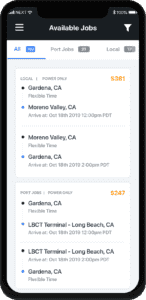When it comes to finding available carriers or independent drivers to haul a load, and knowing when the shipment will arrive at a warehouse, lack of visibility throughout the shipping process creates inefficiencies within the supply chain and can increase shipping costs.
Seeing an opportunity to make it easier to connect carriers and drivers with shippers and provide real-time visibility into shipment status, Next Trucking Inc. developed an online marketplace to connect manufacturers and retailers with carriers based on a driver’s availability, load capacity and location, and enable shippers to see a shipment’s status in real time.
Unlike working through shipping brokers and other means to find available loads for a fee, independent truckers can download Next’s mobile app for free. The app allows drivers to enter their preferences, such as availability, load capacity and preferred rates before seeing available loads. The app then matches available loads to the driver’s criteria.

Bobby Napiltonia, chief revenue officer, Next Trucking
Available loads, which shippers provide by contracting with Next Trucking, show such information as the pick-up point, destination, delivery date and pay. The level of information available to carriers through Next’s platform is more detailed than what they can see through traditional shipping load boards, making it easier for drivers to determine which loads best fit their schedule and provide the best rate of return, says Bobby Napiltonia, chief revenue officer for Next Trucking.
Negotiating for jobs through an app
Next Trucking says this level visibility into load availability and pay rates is especially beneficial to small carriers and independent driver’s, which make up 90% of carriers, because they typically don’t have the time for back-and-forth communications to secure a load and their desired compensation through a broker. Manufacturers using Next Trucking’s platform include Steve Madden Ltd, Hitachi Ltd., Sharp Corp. and Pioneer Electronics Inc.
“Our app eliminates the negotiations between drivers and brokers over available loads and rates, which can be very inefficient,” Napiltonia says.
Increased visibility into available loads makes it easier for carriers and independent drivers to bundle load routes. For example, a driver carrying freight from a port to a department store can arrange to pick up another load nearby for the return trip. Maximizing load capacity throughout a delivery run can increase carrier revenue by 15% on average, Next Trucking says.
“We make it so drivers spend less time driving empty,” Napiltonia adds.

The Next Trucking app shows port jobs available to truckers.
Another area where Next Trucking’s marketplace improves visibility into shipments is through real-time updates as to where a load is in transit. Next’s app uses the GPS on a driver’s mobile phone so shippers can see real-time updates on the carrier’s location and estimated time of arrival.
“When it comes to the supply chain, retailers want to know where their goods are in transit, but can’t always get that information,” says Napiltonia. “Having workers standing around a loading dock waiting for shipment that is late, is inefficient and costs money. Our platform lets shippers see where a load is in transit and when it will arrive so it can better coordinate with warehouse staff.”
Moving goods through ports
As of December, 15,000 drivers had downloaded Next Trucking’s app. The company onboards 300 to 500 new drivers per month, Napiltonia says. Next Trucking, which launched in 2015, vets all drivers downloading its app.
One segment of the shipping market Next is keenly focused on is drayage, which is the process of moving goods in and out of a port. The value of goods moved through ports in the United States is $60 billion annually, according to Next Trucking. Ports in the Los Angeles-Long Beach area move $15 billion of goods annually, Next says.
Next’s platform helps shippers identify unforeseen fees that can increase the cost of drayage shipping. For example, a shipper can get hit with a detention fee at a port, which is levied when a driver is unexpectedly waiting for a shipment to become available.
“Due to the way we operate with the ports, we can help shippers avoid unexpected charges and get drivers in and out more quickly,” says Napiltonia.
Increased visibility into shipping fees can save shippers 10% on average, NextTrucking says.
“Shippers should always know where their goods are in transit and what shipping fees to expect,” says Napiltonia. “That kind of visibility makes the supply chain more efficient.”
Peter Lucas is a Highland Park, Illinois-based freelance journalist covering business and technology.
Sign up for a complimentary subscription to Digital Commerce 360 B2B News, published 4x/week, covering technology and business trends in the growing B2B ecommerce industry. Contact editor Paul Demery at [email protected] and follow him on Twitter @pdemery.
Follow us on LinkedIn and be the first to know when new Digital Commerce 360 B2B News content is published.
Favorite